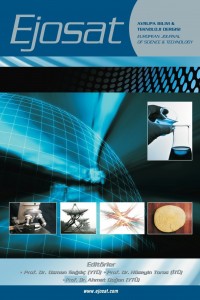Öz
Bu çalışmada NACA 4412 profili kullanılarak bir kanat tasarlanmış ve suction yöntemi ile hesaplamalı sayısal analizi tartışılmıştır. Öncelikle 3 boyutlu kanat SolidWorks programı ile tasarlanmış ve tasarlanan bu kanadın sayısal analizi bir hesaplamalı akışkanlar dinamiği programı olan Ansys Fluent kullanılarak gerçekleştirilmiştir. Sayısal analiz için iki farklı konfigürasyon belirlenmiştir. Bu konfigürasyonlardan ilki olan S1 kanadın yalın halini yani suction olmayan halini ifade ederken; S2 suction kanalına sahip olan kanat tasarımını ifade etmektedir. Oluşturulan kanadın düz uçuşunu 6 derece hücum açısı ile gerçekleştirdiğine karar verilmiş ve bu hücum açısında kanat üzerindeki akış ayrılmalarının kanat chord uzunluğunun %25’ inde meydana geldiği yapılan sayısal analizle tespit edilmiştir. Chord uzunluğunun bu noktasından kanat üst yüzeyinden başlayıp iç kısmından devam eden son olarakta firar kenarından hava ile buluşan bir venturi kanal oluşturulmuştur. Bu kanalın temel amacı uçuş esnasında akışın bozulmaya başladığı yerde kuvvet azaltımı yapılarak aerodinamik performans artışının sağlanabilmesidir. Aerodinamik performanstaki değişimin incelenebilmesi için kanat üzerinde meydana gelen taşıma ve sürükleme katsayısı değerleri her iki konfigürasyon içinde 10 farklı hücum açısında (i.e. -6,-4, -2, 0, 2, 4, 6, 8, 10, 12) ayrı ayrı olacak şekilde elde edilmiştir. S1 ve S2 konfigürasyonları için elde edilen bu katsayı değerleri birbirleri ile karşılaştırılmıştır. Karşılaştırılan sonuçlara göre, yapılan bu sayısal analiz çalışmasında S1 konfigürasyonuna göre S2 konfigürasyonunun performansında belirgin bir artış olduğu tespit edilmiştir.
Anahtar Kelimeler
Kaynakça
- Ansys Fluent Theory Guide, 2013. Austin, R. 2010. Unmanned aircraft systems. Wiley.
- Arik, S., Turkmen, I., & Oktay, T. (2018). Redesign of morphing UAV for simultaneous improvement of directional stability and maximum lift/drag ratio. Advances in Electrical and Computer Engineering, 18(4), 57-63.
- Azim, R., Hasan, M. M., & Ali, M. (2015). Numerical investigation on the delay of boundary layer separation by suction for NACA 4412. Procedia Engineering, 105, 329-334.
- Burnazzi, M., & Radespiel, R. (2015). Synergies between suction and blowing for active high-lift flaps. CEAS Aeronautical Journal, 6(2), 305-318.
- Jansson, J., Hoffman, J., & Jansson, N. (2012). Simulation of 3d unsteady incompressible flow past a naca 0012 wing section.
- Kanat, Ö. Ö., Körpe, D. S., & Kurban, A. O. (2017). Yatay Kuyruklarda Kıvrık Kanat Ucu Kullanımının Aerodinamik Etkileri. Journal of Aviation, 1(2), 87-98.
- Nichols, R. H. (2010). Turbulence models and their application to complex flows. University of Alabama at Birmingham, Revision, 4, 89.
- Oktay, T., & Kanat, O. O. (2017, October). A review of aerodynamic active flow control. In 8th international advanced technologies symposium (IATS'17).
- Prandtl, L. (1927). The generation of vortices in fluids of small viscosity. The Aeronautical Journal, 31(200), 718-741.
- URL-1. https://www.cfd-online.com/Wiki/Turbulence_kinetic_energy
- Vinh, N. X. (1995). Flight mechanics of high-performance aircraft (Vol. 4). Cambridge University Press.
Öz
In this study, a wing is designed by using NACA 4412 profile and computational numerical analysis is discussed with suction method. First of all, the 3D wing is designed with the SolidWorks and the numerical study of this designed wing is carried out using ANSYS Fluent, a famous CFD (i.e. Computational Fluid Dynamics) software. It is based upon finite volume method approach. Two different configurations are used for numerical study. The first of these configurations is the S1, which represents the initial state of the wing; S2 refers to the wing design with suction channel. The straight flight angle of attack of the wing is 6 degree and the flow separations over the wing, which occurred in 25% of the wing chord length, are calculated at this angle of attack by the numerical study. At this point of chord length, a venturi channel is formed which initial point is the upper surface of the wing and throughout the inner part and finally meets with air from the trailing edge. The main purpose of this channel is to decrease the force at the place where the flow begins to deteriorate during the flight and to increase the aerodynamic performance. In order to be able to examine the change in aerodynamic performance, the lift and drag coefficient values on the wing are obtained in 10 angles of attack (i.e. -6, -4, -2, 0, 2, 4, 6, 8, 10, 12) separately for both configurations. These coefficients obtained for S1 and S2 configurations are compared with each other. In this numerical study based on the comparison results, it is found that there is a significant increase in the performance of S2 configuration compared to the S1 configuration.
Anahtar Kelimeler
Kaynakça
- Ansys Fluent Theory Guide, 2013. Austin, R. 2010. Unmanned aircraft systems. Wiley.
- Arik, S., Turkmen, I., & Oktay, T. (2018). Redesign of morphing UAV for simultaneous improvement of directional stability and maximum lift/drag ratio. Advances in Electrical and Computer Engineering, 18(4), 57-63.
- Azim, R., Hasan, M. M., & Ali, M. (2015). Numerical investigation on the delay of boundary layer separation by suction for NACA 4412. Procedia Engineering, 105, 329-334.
- Burnazzi, M., & Radespiel, R. (2015). Synergies between suction and blowing for active high-lift flaps. CEAS Aeronautical Journal, 6(2), 305-318.
- Jansson, J., Hoffman, J., & Jansson, N. (2012). Simulation of 3d unsteady incompressible flow past a naca 0012 wing section.
- Kanat, Ö. Ö., Körpe, D. S., & Kurban, A. O. (2017). Yatay Kuyruklarda Kıvrık Kanat Ucu Kullanımının Aerodinamik Etkileri. Journal of Aviation, 1(2), 87-98.
- Nichols, R. H. (2010). Turbulence models and their application to complex flows. University of Alabama at Birmingham, Revision, 4, 89.
- Oktay, T., & Kanat, O. O. (2017, October). A review of aerodynamic active flow control. In 8th international advanced technologies symposium (IATS'17).
- Prandtl, L. (1927). The generation of vortices in fluids of small viscosity. The Aeronautical Journal, 31(200), 718-741.
- URL-1. https://www.cfd-online.com/Wiki/Turbulence_kinetic_energy
- Vinh, N. X. (1995). Flight mechanics of high-performance aircraft (Vol. 4). Cambridge University Press.
Ayrıntılar
| Birincil Dil | İngilizce |
|---|---|
| Konular | Mühendislik |
| Bölüm | Makaleler |
| Yazarlar | |
| Yayımlanma Tarihi | 31 Aralık 2019 |
| Yayımlandığı Sayı | Yıl 2019 Sayı: 17 |

